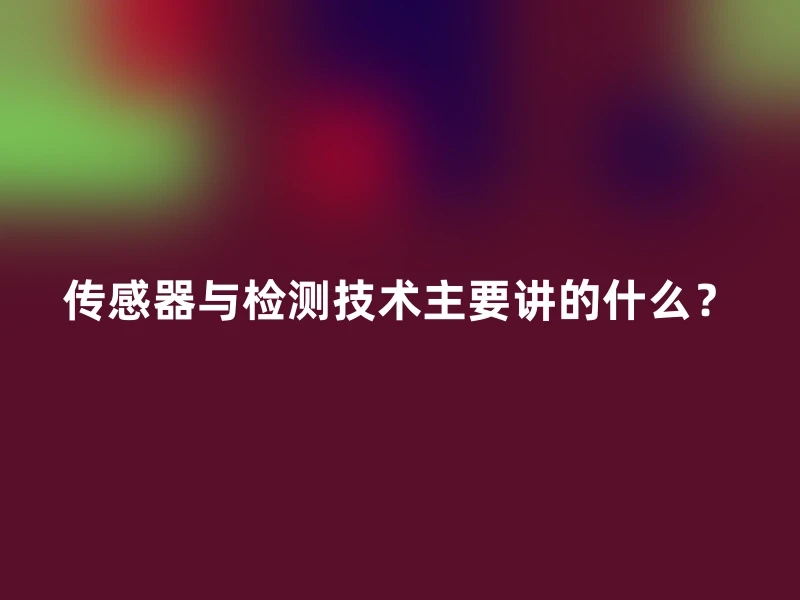Categorization:Product Information
Sensors and Detection Technology" mainly introduces the composition of commonly used sensors, working principle, characteristics and parameters, selection and installation and commissioning and other aspects of knowledge, the basic concepts of measurement circuits, anti-jamming technology and the application of new types of sensors are also introduced. The book lists various types of sensors in industry, scientific research and daily life in the application of examples. Each chapter is accompanied by reflection questions and exercises, focusing on cultivating and improving students' application ability and analytical ability. Sensors and Detection Technology can be used as a teaching book for higher vocational colleges and universities specializing in electromechanical equipment, automation, electronic information and computer applications, and can also be used as a reference for engineers and technicians in related fields.
Sensor and Detection Technology" is the frontier technology of modern science and technology, the foundation of manufacturing automation and informationization, the second special network and the future "ubiquitous network" information source of important supporting technology, is suitable for electromechanical, automation, aviation, navigation and aerospace and other professional basic courses. Sensor and detection technology involves a variety of physical quantities, chemical quantities, biological quantities, such as measurement, transformation and processing, is a very wide range of applications, industrial and agricultural production, national defense and other courses of great significance. The course involves physics, chemistry, test metrology, electronics, mechanics, communications, computers, automatic control, instrumentation and many other disciplines, its theory and practice are very strong. Learning this specialized basic course will play a very important role in students' future work, therefore, domestic and foreign colleges and universities attach great importance to the teaching of this course. "Sensors and detection technology" course in the content of the field of detection technology, including some of the basic concepts and measurement methods, error analysis and measurement data processing, the general characteristics of the sensor analysis, a variety of commonly used sensors (such as resistance, inductance, capacitance, piezoelectricity, magnetoelectricity, thermoelectricity, photoelectricity, etc.), the working principle, structure, nonlinear error compensation, the working principle, structure, and nonlinear error compensation, the use of sensors in the future. The course focuses on the accumulation of theoretical basic knowledge as well as the cultivation of practical engineering measurement and control technology and advanced scientific methods. Learning the course well is important for the students' graduation design, electronic design and data processing.

The main idea is to use a method to convert the detected object into a signal that can be directly measured.
I. Currently this discipline focuses on signaling. For this subject the main detection methods and sensors include: capacitive sensors, resistive sensors, piezoelectric sensors, inductive sensors, photoelectric sensors and so on. It should be noted that there are currently more than 10,000 kinds of sensors, it is because of the different environments being applied and the difference between the detected objects make the sensors and detection methods very diverse.
Second, in addition to the knowledge of the previous object, but also need to understand the accuracy and error problems or theories. For example, relative accuracy, absolute accuracy and other knowledge. It should be noted that for the precision of the word has been debated, the current academic community began to unify to the uncertainty of the beginning of transformation
Sensor and Detection Technology Question Paper
I. Single-choice questions (10 questions, 2 points each, 20 points in total) Only one of the four options listed in each question is in line with the requirements of the question, so please fill in the code in parentheses after the question. No marks for wrong choice or no choice.
1, belonging to the sensor static characteristic index is [ ]
A. Intrinsic Frequency B. Critical Frequency
C. Damping ratio D. Repeatability
2、Differential transformer belongs to [ ]
A. Physical sensors B. Structural sensors
C. Resistive sensors D. Inductive sensors
3、The following one is not a basic form of circuit parametric sensor is [ ]
A. Resistive
If we use the analogy of a human being, the sensors are the eyes, ears, and nose, plus the skin. They sense external information, and the detection technology is the brain, which is used to analyze and decide on trade-offs.